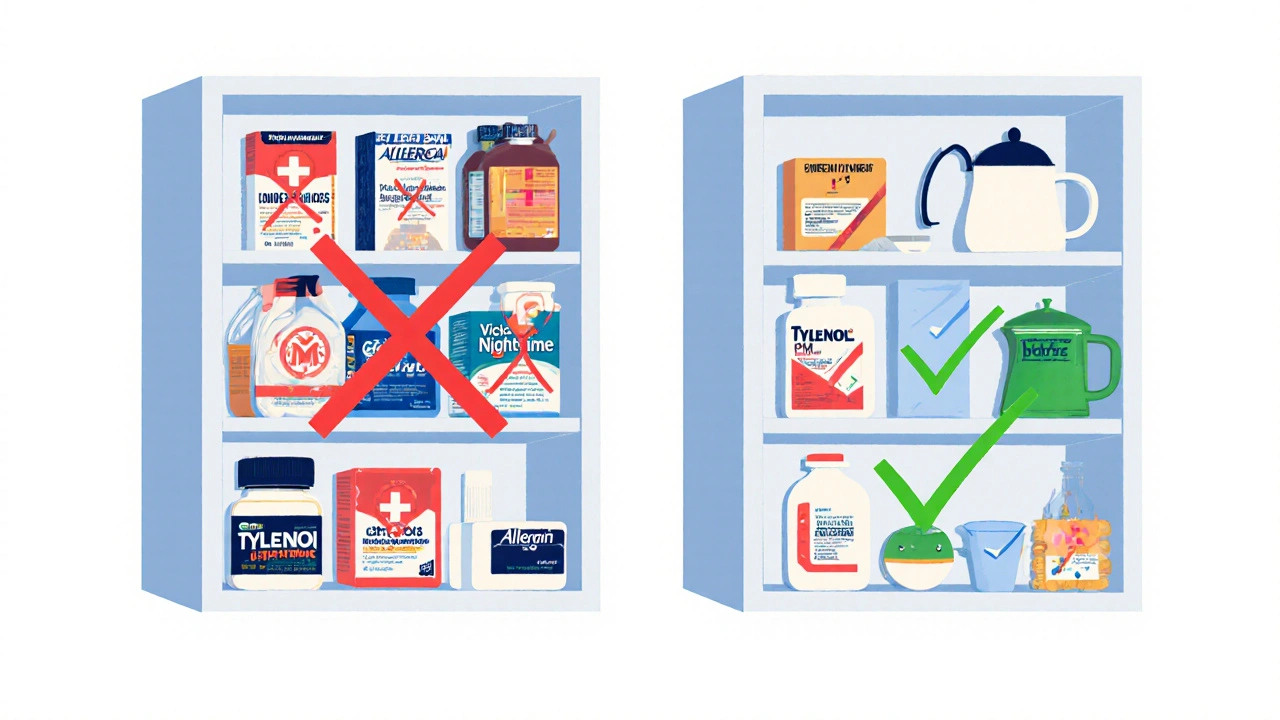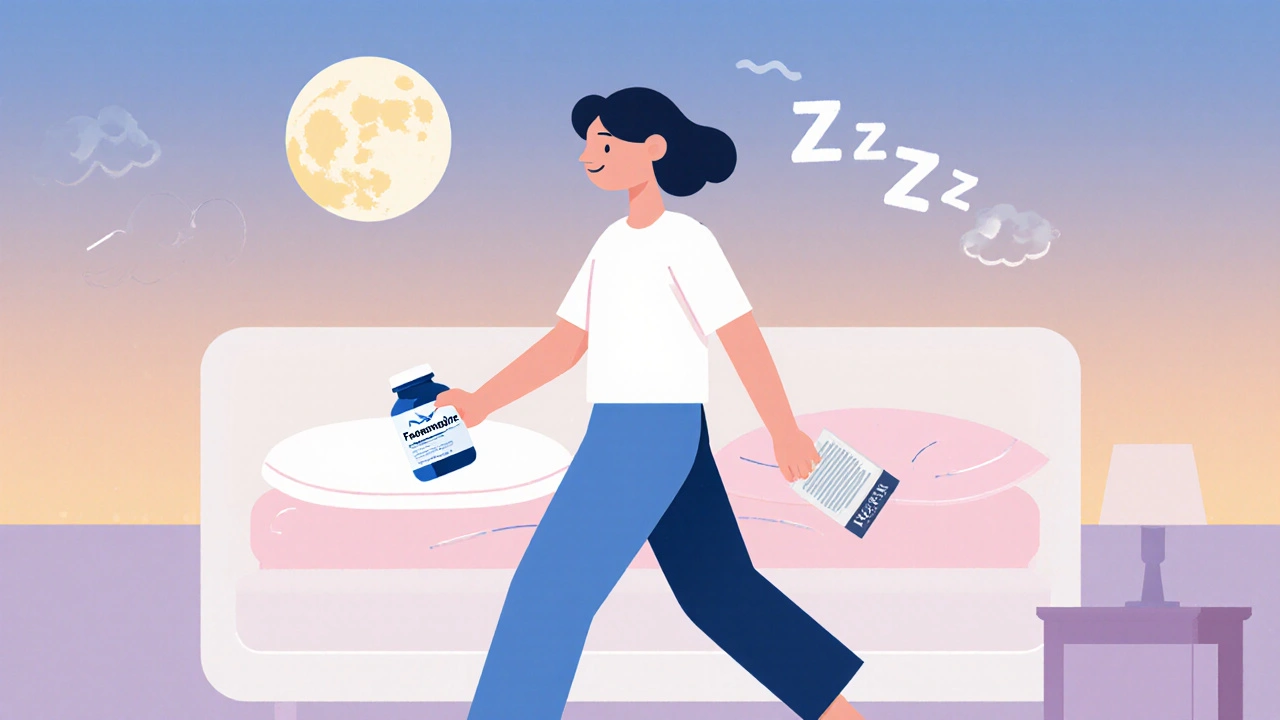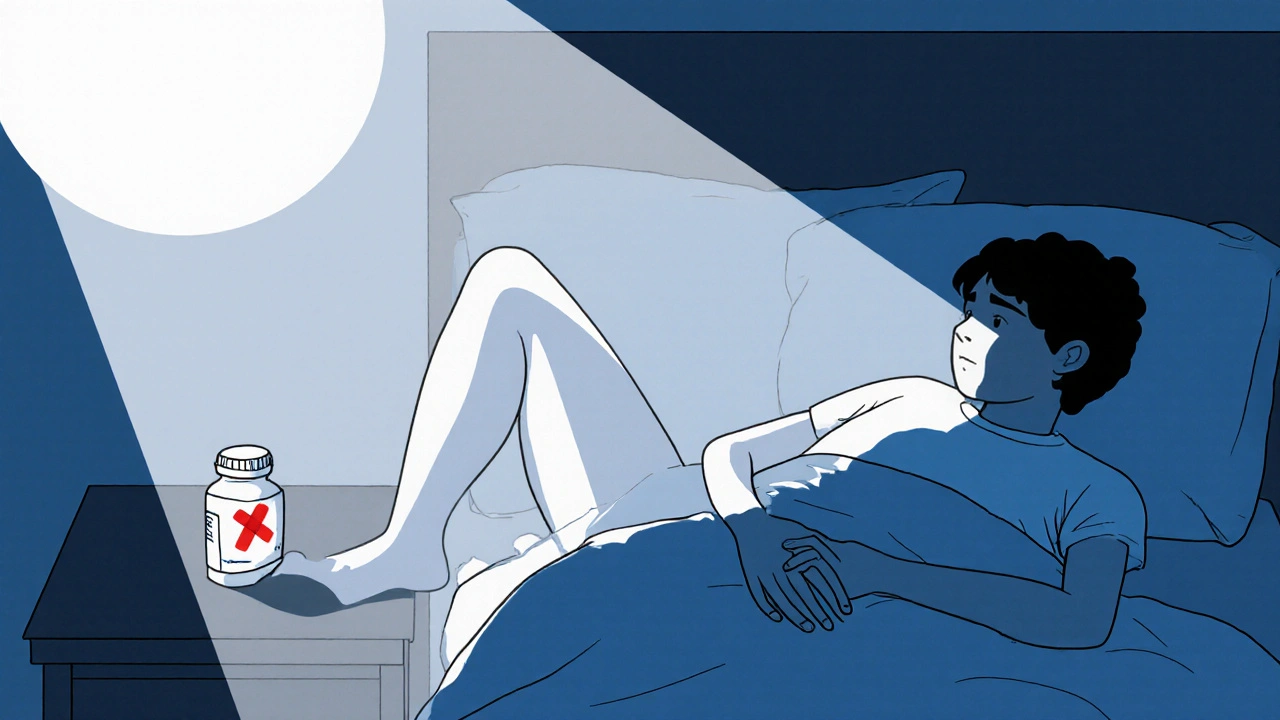Antihistamine Checker for RLS
Check Your Allergy Medication
Enter a medication name to see if it contains sedating antihistamines that may worsen your restless legs symptoms.
If you have restless legs syndrome (RLS), you already know how frustrating it is-those crawling, tingling, or aching sensations in your legs that hit hardest at night, making sleep nearly impossible. Now imagine taking a common allergy pill to clear your sinuses, only to find your legs feel worse than ever. That’s not just bad luck. It’s a well-documented reaction tied to the very chemistry of many over-the-counter antihistamines.
Why Sedating Antihistamines Make RLS Worse
Many people reach for diphenhydramine (Benadryl), chlorpheniramine (Piriton), or hydroxyzine (Atarax) when they have allergies, colds, or trouble sleeping. These are called first-generation antihistamines. They work by blocking histamine, the chemical that triggers sneezing and runny noses. But they also easily cross the blood-brain barrier because they’re fat-soluble. That’s where the problem starts. Inside the brain, these drugs don’t just block histamine-they accidentally block dopamine receptors too. Dopamine is the brain’s natural signal for smooth movement and sleep regulation. In RLS, dopamine pathways are already underactive. When a sedating antihistamine steps in and blocks dopamine further, it’s like turning off a dimmer switch that was barely on to begin with. The result? More intense leg urges, longer nights awake, and a cycle of worsening symptoms. Research backs this up. A 2014 study of over 16,000 kidney patients found those taking sedating antihistamines were nearly twice as likely to develop RLS symptoms. Another analysis from Houston Methodist’s Movement Disorders Clinic showed that 78% of RLS patients reported clear worsening after taking Benadryl or similar meds. And it’s not just anecdotal. On RLS forums, users consistently report nights spent pacing the floor after taking nighttime cold medicine.What’s in Your Medicine Cabinet? Watch Out for These
You might not realize how many products contain these risky ingredients. Sedating antihistamines aren’t just in allergy pills-they’re hidden in nighttime pain relievers, cough syrups, and sleep aids. Here’s a quick list of common products that contain diphenhydramine, doxylamine, or chlorpheniramine:- Benadryl
- Advil PM
- Bayer PM
- Tylenol PM
- Comtrex
- Contact Cold & Flu
- Dimetapp
- TheraFlu Nighttime
- Triaminic Nighttime
- Vicks Cough and Cold Nighttime
- Night Nurse (UK)
Safe Alternatives: The Non-Sedating Options
Good news: you don’t have to suffer through allergy season with no relief. Second-generation antihistamines are designed to stay out of the brain. They’re filtered by a natural transport system called P-glycoprotein, which keeps them from crossing into the central nervous system. That means they treat your allergies without messing with your dopamine. These are the safer choices:- Fexofenadine (Allegra)
- Loratadine (Claritin)
- Desloratadine (Clarinex)
- Cetirizine (Zyrtec)

What About Decongestants? They Can Make Things Worse Too
Don’t forget about decongestants. Many allergy and cold products combine antihistamines with pseudoephedrine or phenylephrine. These stimulants can raise blood pressure and make RLS worse by overstimulating the nervous system. A 2016 RLS-UK database found that 35% of RLS patients saw symptom spikes after taking decongestants-even if the antihistamine part was safe. So avoid combo products like Sudafed PE Cold & Allergy, Claritin-D, or Zyrtec-D. If you need a decongestant, talk to your doctor. Sometimes, nasal sprays like fluticasone (Flonase) work just as well for congestion without affecting your legs. One Vanderbilt study showed 82% of RLS patients had better symptom control using nasal steroids instead of oral meds.Other Ways to Manage Allergies Without Worsening RLS
If you’re looking for non-medication ways to handle allergies, here’s what works:- Saline nasal rinses (neti pots or squeeze bottles): 76% of RLS patients report reduced congestion without side effects.
- HEPA air filters: Reduce dust, pollen, and pet dander in your bedroom-where you need rest the most.
- Washing bedding weekly in hot water: Dust mites are a major trigger. Hot water kills them.
- Keep windows closed during high pollen seasons: Especially in the morning when pollen counts peak.

How Long Does It Take to See Improvement?
Switching from a sedating antihistamine to a safer one doesn’t always fix things overnight. But most people notice a difference within 24 to 48 hours. One patient on the RLS Foundation forum wrote: "Took Benadryl for allergies. Couldn’t sleep for three nights. Switched to Claritin. Slept like a baby the next night." The key is consistency. Give your body a few days to reset. Avoid all sedating antihistamines during this time-even in cough syrups or sleep aids. If you’re still struggling after a week, talk to your doctor about other triggers-iron levels, caffeine, or even certain antidepressants can also worsen RLS.Why This Matters More Than You Think
RLS affects about 12 million people in the U.S. alone, and many more worldwide. Yet, most doctors don’t ask about medication use unless you bring it up. A Cleveland Clinic study of 5,000 RLS patients found that 25% were unknowingly taking something that made their symptoms worse-mostly sedating antihistamines. This isn’t just about comfort. Poor sleep from RLS increases risk for depression, heart disease, and diabetes. Managing your meds is part of managing your long-term health. Insurance companies are catching on too. As of 2023, 98% of Medicare Part D plans cover non-sedating antihistamines with low copays, while coverage for sedating ones has dropped. The American Academy of Neurology now includes antihistamine warnings in their official RLS treatment guidelines.What to Do Next
If you have RLS and take allergy meds:- Check every medicine bottle in your bathroom cabinet. Look for diphenhydramine, doxylamine, or chlorpheniramine.
- Replace any sedating antihistamine with fexofenadine (Allegra) or loratadine (Claritin).
- Avoid combo products with decongestants.
- Try saline rinses or nasal sprays for congestion.
- Track your symptoms for a week. If your legs feel calmer, you’ve found your solution.
Can Zyrtec make restless legs worse?
Yes, for some people. While Zyrtec (cetirizine) is labeled "non-sedating," about 15% of RLS patients report mild to moderate worsening of symptoms after taking it. This is likely because it still has slight central nervous system activity compared to fexofenadine or loratadine, which affect the brain even less. If you notice your legs feel worse after taking Zyrtec, switch to Allegra or Claritin. Most patients find relief within a day or two.
Is Benadryl the worst antihistamine for RLS?
Yes, Benadryl (diphenhydramine) is one of the worst. It crosses the blood-brain barrier easily and strongly blocks dopamine receptors, which directly worsens RLS symptoms. Studies show 78% of RLS patients report significant symptom spikes after taking it. It’s also found in many nighttime cold and sleep aids, making accidental use common. Avoid it completely if you have RLS.
Can I take Claritin with RLS?
Yes, Claritin (loratadine) is one of the safest antihistamines for RLS. It barely enters the brain, so it doesn’t interfere with dopamine pathways. Patient surveys show only 5-8% of RLS users report any worsening, and most say their symptoms stay the same or improve. It’s the top recommendation from the RLS Foundation and neurologists for allergy sufferers with RLS.
Do decongestants make restless legs worse?
Yes. Decongestants like pseudoephedrine and phenylephrine can stimulate the nervous system and make RLS symptoms worse. About 35% of RLS patients report increased leg discomfort after taking decongestants-even if the antihistamine part of the medicine is safe. Avoid combo products like Claritin-D or Sudafed PE Cold & Allergy. Use saline rinses or nasal sprays like Flonase instead.
What’s a safe sleep aid for RLS patients?
Melatonin is the safest option. Unlike sedating antihistamines, melatonin doesn’t block dopamine. A 2021 study found that 65% of RLS patients improved their sleep with 0.5-5 mg of melatonin taken before bed, with no worsening of leg symptoms. Avoid sleep aids with diphenhydramine or doxylamine-they’ll make your RLS worse. Always check the label.

Conor McNamara
so u know those 'non-sedating' antihistamines? lol. theyre just the gov'ts way of keepin us docile while the pharma giants sell us the same poison in a prettier bottle. i checked my claritin bottle-diphenhydramine was listed as a 'inactive ingredient' under 'other components' in tiny font. theyre lying. theyre always lying. i stopped taking everything. now i just rub salt on my legs at night. works better anyway.